Thomas Zwick
Institute of Radio Frequency Engineering and Electronics
System Concept and Demonstration of Bistatic MIMO-OFDM-based ISAC
Apr 10, 2025Abstract:In future sixth-generation (6G) mobile networks, radar sensing is expected to be offered as an additional service to its original purpose of communication. Merging these two functions results in integrated sensing and communication (ISAC) systems. In this context, bistatic ISAC appears as a possibility to exploit the distributed nature of cellular networks while avoiding highly demanding hardware requirements such as full-duplex operation. Recent studies have introduced strategies to perform required synchronization and data exchange between nodes for bistatic ISAC operation, based on orthogonal frequency-division multiplexing (OFDM), however, only for single-input single-output architectures. In this article, a system concept for a bistatic multiple-input multiple-output (MIMO)-OFDM-based ISAC system with beamforming at both transmitter and receiver is proposed, and a distribution synchronization concept to ensure coherence among the different receive channels for direction-of-arrival estimation is presented. After a discussion on the ISAC processing chain, including relevant aspects for practical deployments such as transmitter digital pre-distortion and receiver calibration, a 4x8 MIMO measurement setup at 27.5 GHz and results are presented to validate the proposed system and distribution synchronization concepts.
Joint BS Deployment and Power Optimization for Minimum EMF Exposure with RL in Real-World Based Urban Scenario
Apr 07, 2025Abstract:Conventional base station (BS) deployments typically prioritize coverage, quality of service (QoS), or cost reduction, often overlooking electromagnetic field (EMF) exposure. Whereas EMF exposure triggers significant public concern due to its potential health implications, making it crucial to address when deploying BS in densely populated areas. To this end, this paper addresses minimizing average EMF exposure while maintaining coverage in a 3D urban scenario by jointly optimizing BS deployment and power. To address this, firstly, accurate EMF prediction is essential, as traditional empirical models lack the required accuracy, necessitating a deterministic channel model. A novel least-time shoot-and-bounce ray (SBR) ray-launching (RL) algorithm is therefore developed to overcome several limitations of current simulators and is validated with real-world measurements. Secondly, to further reduce computational complexity, unlike using a fixed grid size to discretize the target area, the adaptive grid refinement (AGR) algorithm is designed with a flexible grid to predict the overall EMF exposure. Finally, based on the EMF exposure predictions, the Nelder-Mead (NM) method is used in the joint optimization, and urban user equipment (UE) distributions are incorporated to better reflect real-world conditions. When evaluating the benefits of the whole process, the results are compared against using empirical channel models, revealing notable differences and underestimation of EMF exposure that highlight the importance of considering real-world scenario.
On the Sensing Performance of OFDM-based ISAC under the Influence of Oscillator Phase Noise
Oct 17, 2024Abstract:Integrated sensing and communication (ISAC) is a novel capability expected for sixth generation (6G) cellular networks. To that end, several challenges must be addressed to enable both mono- and bistatic sensing in existing deployments. A common impairment in both architectures is oscillator phase noise (PN), which not only degrades communication performance, but also severely impairs radar sensing. To enable a broader understanding of orthogonal-frequency division multiplexing (OFDM)-based sensing impaired by PN, this article presents an analysis of sensing peformance in OFDM-based ISAC for different waveform parameter choices and settings in both mono- and bistatic architectures. In this context, the distortion of the adopted digital constellation modulation is analyzed and the resulting PN-induced effects in range-Doppler radar images are investigated both without and with PN compensation. These effects include peak power loss of target reflections and higher sidelobe levels, especially in the Doppler shift direction. In the conducted analysis, these effects are measured by the peak power loss ratio, peak-to-sidelobe level ratio, and integrated sidelobe level ratio parameters, the two latter being evaluated in both range and Doppler shift directions. In addition, the signal-to-interference ratio is analyzed to allow not only quantifying the distortion of a target reflection, but also measuring the interference floor level in a radar image. The achieved results allow to quantify not only the PN-induced impairments to a single target, but also how the induced degradation may impair the sensing performance of OFDM-based ISAC systems in multi-target scenarios.
Pilot-Based SFO Estimation for Bistatic Integrated Sensing and Communication
Jul 10, 2024Abstract:Enabling bistatic radar sensing within the context of integrated sensing and communication (ISAC) for future sixth generation mobile networks demands strict synchronization accuracy, which is particularly challenging to be achieved with over-the-air synchronization. Existing algorithms handle time and frequency offsets adequately, but provide insufficiently accurate sampling frequency offset (SFO) estimates that result in degradation of obtained radar images in the form of signal-to-noise ratio loss and migration of range and Doppler shift. This article introduces an SFO estimation algorithm named tilt inference of time offset (TITO) for orthogonal frequency-division multiplexing (OFDM)-based ISAC. Using available pilot subcarriers, TITO obtains channel impulse response estimates and extracts information on the SFO-induced delay migration to a dominant reference path with constant range, Doppler shift, and angle between transmit and receive ISAC nodes. TITO then adaptively selects the delay estimates that are only negligibly impaired by SFO-induced intersymbol interference, ultimately employing them to estimate the SFO. Assuming a scenario without a direct line-of-sight (LoS) between the aforementioned transmitting and receiving ISAC nodes, a system concept with a relay reflective intelligent surface (RIS) is used to create the aforementioned reference path is proposed. Besides a mathematical derivation of accuracy bounds, simulation and measurements at 26.2 GHz are presented to demonstrate TITO's superiority over existing methods in terms of SFO estimation accuracy and robustness.
Bridging Simulation and Measurements through Ray-Launching Analysis: A Study in a Complex Urban Scenario Environment
Jun 12, 2024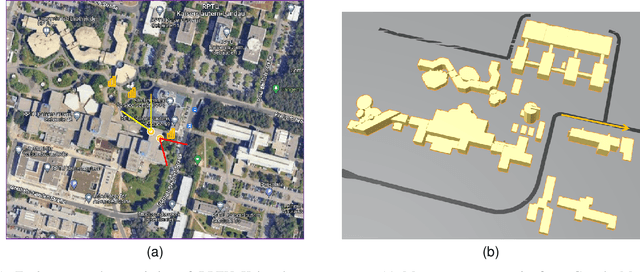

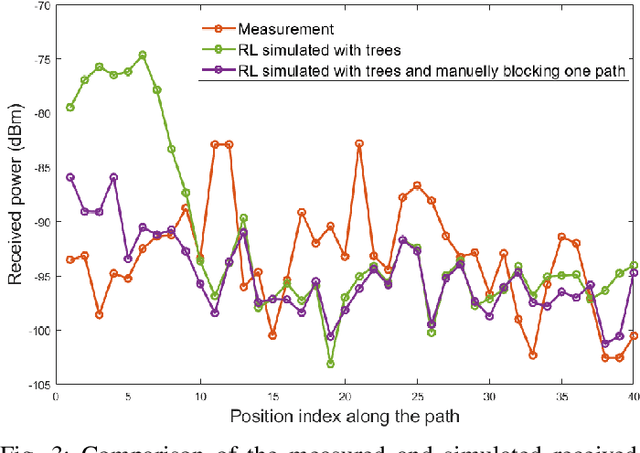

Abstract:With the rapid increase in mobile subscribers, there is a drive towards achieving higher data rates, prompting the use of higher frequencies in future wireless communication technologies. Wave propagation channel modeling for these frequencies must be considered in conjunction with measurement results. This paper presents a ray-launching (RL)-based simulation in a complex urban scenario characterized by an undulating terrain with a high density of trees. The simulation results tend to closely match the reported measurements when more details are considered. This underscores the benefits of using the RL method, which provides detailed space-time and angle-delay results.
Bistatic OFDM-based ISAC with Over-the-Air Synchronization: System Concept and Performance Analysis
May 08, 2024



Abstract:Integrated sensing and communication (ISAC) has been defined as one goal for 6G mobile communication systems. In this context, this article introduces a bistatic ISAC system based on orthogonal frequency-division multiplexing (OFDM). While the bistatic architecture brings advantages such as not demanding full duplex operation with respect to the monostatic one, the need for synchronizing transmitter and receiver is imposed. In this context, this article introuces a bistatic ISAC signal processing framework where an incoming OFDM-based ISAC signal undergoes over-the-air synchronization based on preamble symbols and pilots. Afterwards, bistatic radar processing is performed using either only pilot subcarriers or the full OFDM frame. The latter approach requires estimation of the originally transmitted frame based on communication processing and therefore error-free communication, which can be achieved via appropriate channel coding. The performance and limitations of the introduced system based on both aforementioned approaches are assessed via an analysis of the impact of residual synchronization mismatches and data decoding failures on both communication and radar performances. Finally, the performed analyses are validated by proof-of-concept measurement results.
Enabling Joint Radar-Communication Operation in Shift Register-Based PMCW Radars
May 24, 2023Abstract:This article introduces adaptations to the conventional frame structure in binary phase-modulated continuous wave (PMCW) radars with sequence generation via linear-feedbck shift registers and additional processing steps to enable joint radar-communication (RadCom) operation. In this context, a preamble structure based on pseudorandom binary sequences (PRBSs) that is compatible with existing synchronization algorithms is outlined, and the allocation of pilot PRBS blocks is discussed. Finally, results from proof-of-concept measurements are presented to illustrate the effects of the choice of system and signal parameters and validate the investigated PMCW-based RadCom system and synchronization strategy.
Bistatic OFDM-based Joint Radar-Communication: Synchronization, Data Communication and Sensing
May 24, 2023Abstract:This article introduces a bistatic joint radar-communication (RadCom) system based on orthogonal frequency-division multiplexing (OFDM). In this context, the adopted OFDM frame structure is described and system model encompassing time, frequency, and sampling synchronization mismatches between the transmitter and receiver of the bistatic system is outlined. Next, the signal processing approaches for synchronization and communication are discussed, and radar sensing processing approaches using either only pilots or a reconstructed OFDM frame based on the estimated receive communication data are presented. Finally, proof-of-concept measurement results are presented to validate the investigated system and a trade-off between frame size and the performance of the aforementioned processing steps is observed.
Slice-Less Optical Arbitrary Waveform Measurement (OAWM) in a Bandwidth of More than 600 GHz Using Soliton Microcombs
Mar 31, 2023



Abstract:We propose and demonstrate a novel scheme for optical arbitrary waveform measurement (OAWM) that exploits chip-scale Kerr soliton combs as highly scalable multiwavelength local oscillators (LO) for ultra-broadband full-field waveform acquisition. In contrast to earlier concepts, our approach does not require any optical slicing filters and thus lends itself to efficient implementation on state-of-the-art high-index-contrast integration platforms such as silicon photonics. The scheme allows to measure truly arbitrary waveforms with high accuracy, based on a dedicated system model which is calibrated by means of a femtosecond laser with known pulse shape. We demonstrated the viability of the approach in a proof-of-concept experiment by capturing an optical waveform that contains multiple 16 QAM and 64 QAM wavelength-division multiplexed (WDM) data signals with symbol rates of up to 80 GBd, reaching overall line rates of up to 1.92 Tbit/s within an optical acquisition bandwidth of 610 GHz. To the best of our knowledge, this is the highest bandwidth that has so far been demonstrated in an OAWM experiment.
Discrete-Fresnel Domain Channel Estimation in OCDM-based Radar Systems
Jul 21, 2022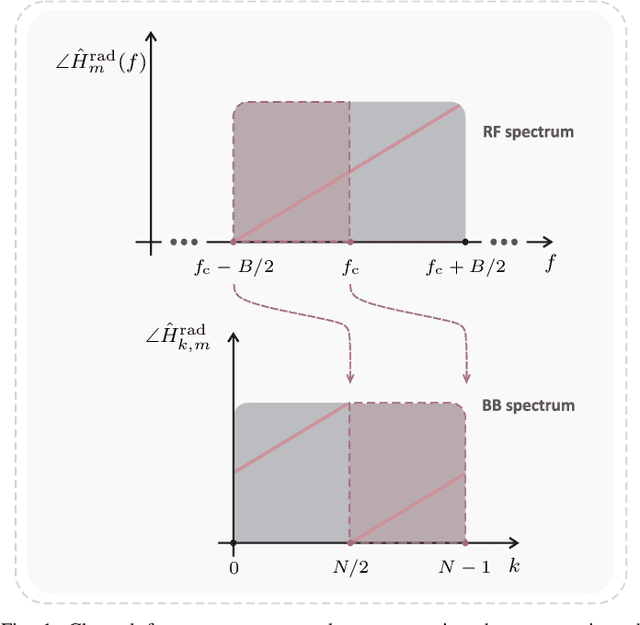
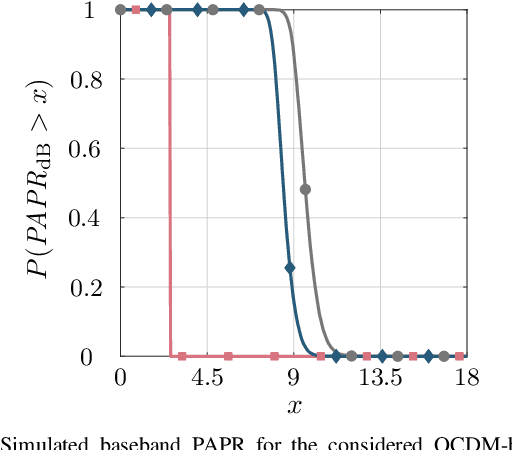
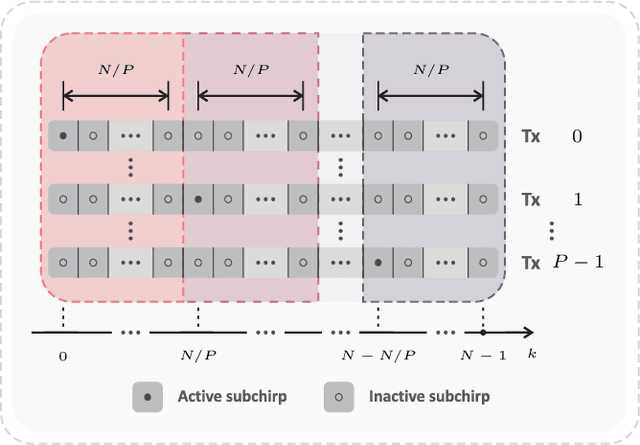
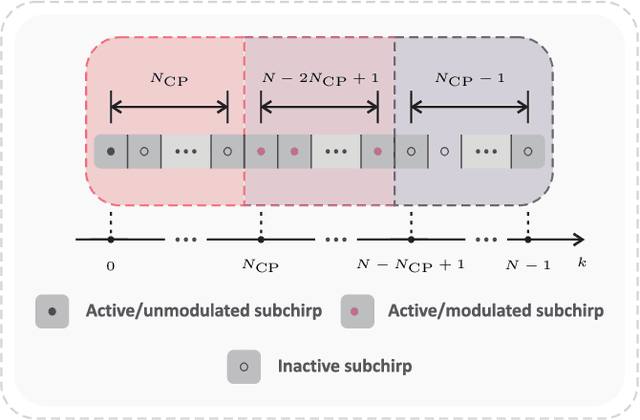
Abstract:In recent years, orthogonal chirp-division multiplexing (OCDM) has been increasingly considered as an alternative multicarrier scheme, e.g., to orthogonal frequency-division multiplexing, in digital communication applications. Among reasons for thar are its demonstrated superior performance resulting from its robustness to impairments such as frequency selectivity of channels and intersymbol interference. Furthermore, the so-called unbiased channel estimation in the discrete-Fresnel domain has also been investigated for both communication and sensing systems, however without considering the effects of frequency shifts. This article investigates the suitability of the aforementioned discrete-Fresnel domain channel estimation in OCDM-based radar systems as an alternative to the correlation-based processing previously adopted, e.g., in the radar-communication (RadCom) literature, which yields high sidelobe level depending on the symbols modulated onto the orthogonal subchirps. In this context, a mathematical formulation for the aforementioned channel estimation approach is introduced. Additionally, extensions to multi-user/multiple-input multiple-output and RadCom operations are proposed. Finally, the performance of the proposed schemes is analyzed, and the presented discussion is supported by simulation and measurement results. In summary, all proposed OCDM-based schemes yield comparable radar sensing performance to their orthogonal frequency-division multiplexing counterpart, while achieving improved peak-to-average power ratio and, in the RadCom case, communication performance.
 Add to Chrome
Add to Chrome Add to Firefox
Add to Firefox Add to Edge
Add to Edge